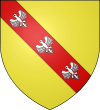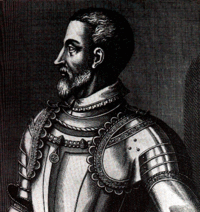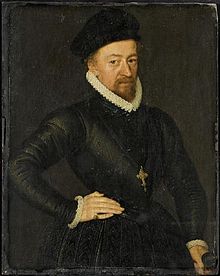- Francis, Duke of Guise
-
 Francis, Duke of Guise, by François Clouet
Francis, Duke of Guise, by François Clouet
Francis de Lorraine II, Prince of Joinville, Duke of Guise, Duke of Aumale (17 February 1519 – 24 February 1563), called Balafré ("the scarred"), was a French soldier and politician.
Contents
Early life
Born at Bar-le-Duc (Lorraine), Guise was the son of Claude, Duke of Guise (created Duke of Guise in 1527), and his wife Antoinette de Bourbon. His sister, Mary of Guise, was the wife of James V of Scotland and mother of Mary, Queen of Scots. His younger brother was Charles, Cardinal of Lorraine. He was the youthful cousin of Henry II of France, with whom he was raised and by birth a prominent individual in France, though his detractors emphasised his "foreign" origin, namely the Duchy of Lorraine.
In 1545, he gained his sobriquet through a wound sustained at the Second Siege of Boulogne. In 1548 he was magnificently wedded to Anna d'Este, daughter of the duke of Ferrara, Ercole II d'Este and his French princess, Renée, the daughter of Louis XII.
Military career
In 1551, he was created Grand Chamberlain of France. He won international renown in 1552 when he successfully defended the city of Metz from the forces of Charles V, Holy Roman Emperor, and defeated the imperial troops again at the Battle of Renty in 1554,[1] but the Truce of Vaucelles temporarily curtailed his military activity.
He led an army into Italy in 1557 to aid Pope Paul IV (and probably to further his family's pretensions to the Angevin inheritance), but was recalled to France and made Lieutenant-General of France after the defeat of the Constable de Montmorency at the Battle of St. Quentin. Taking the field, he captured Calais from the English on 7 January 1558— an enormous propaganda victory for France— then Thionville and Arlon that summer, and was preparing to advance into Luxembourg when the Peace of Cateau-Cambrésis was signed. Throughout the reign of Henry II Guise was the premier military figure of France, courteous, affable and frank, and universally popular, the "grand duc de Guise" as his contemporary Brantôme called him. [2]
The accession of Francis's niece Mary, Queen of Scots, and her husband, Francis II of France (10 July 1559), however, was a triumph for the Guise family, and the Grand Master of France Montmorency was disgraced and sent from court. The Duke of Guise and his brother, Charles, Cardinal of Lorraine were supreme in the royal council.[3] "My advice", he would say, "is so-and-so; we must act thus." Occasionally he signed public acts in the royal manner, with his baptismal name only.
The Wars of Religion
In reaction to the power at court of the ultra-Catholic Guise, La Renaudie, a Protestant gentleman of Périgord, perhaps at the distanced instigation of Louis of Bourbon, Prince of Conde, organized an amateurish plot (the conspiracy of Amboise, 1560) to seize the person of the Duke of Guise and his brother Charles, the Cardinal of Lorraine. The plot was discovered and violently suppressed, initiating a series of assassinations and counter-assassinations in an increasingly toxic atmosphere. In the immediate aftermath Condé was obliged to flee the court, and the power of the Guises was supreme. The discourse which Coligny, leader of the Huguenots, pronounced against les Guises in the Assembly of the notables at Fontainebleau (August, 1560), did not influence King Francis II in the least, but resulted rather in the imprisonment of Condé, at Charles's behest.
The king, however, died, 5 December 1560—a year full of calamity for the Guises both in Scotland and France. Within a few months their influence waxed great and waned. After the accession of Charles IX, the Duke of Guise lived in retirement on his estates. The regent, Catherine de' Medici, at first inclined to favour the Protestants. To defend the Catholic cause, the Duke of Guise formed with his old enemy, the Constable de Montmorency and the Maréchal de Saint-André the so-called triumvirate (April, 1561) at the head of the Catholic League, opposed to the policy of concessions which Catherine de' Medici attempted to inaugurate in favour of the Protestants. His former military hero's public image was changing: 'he could not serve for long as the military executive of this extreme political, ultra-montane, pro-Spanish junta without attracting his share of odium," N. M. Sutherland has observed in describing the lead-up to his assassination.[4]
The plan of the Triumvirate was to treat with Habsburg Spain and the Holy See, and also to come to an understanding with the Lutheran princes of Germany to induce them to abandon the idea of relieving the French Protestants. About July, 1561, Guise wrote to this effect to the Duke of Württemberg. The Colloquy of Poissy (September and October 1561) between theologians of the two confessions was fruitless, and the conciliation policy of Catherine de' Medici was defeated. From 15 to 18 February, 1562, Guise visited the Duke of Württemberg at Saverne, and convinced him that if the conference at Poissy had failed, the fault was that of the Calvinists.
As Guise passed through Wassy-sur-Blaise on his way to Paris (1 March 1562), a massacre of Protestants took place. It is not known to what extent he was responsible for this, but what came to be known as the "Massacre of Vassy" kindled open military conflict in the French Wars of Religion. The siege of Bourges in September was the opening episode, then Rouen was retaken from the Protestants by Guise after a month's siege (October); the Battle of Dreux (19 December), at which Montmorency was taken prisoner and Saint-André slain, was in the end turned by Guise to the advantage of the Catholic cause, and Condé, leader of the Huguenots, taken prisoner.
The assassination
In the fourth encounter, Guise was about to take Orléans from the Huguenot supporters of Condé when he was wounded on 18 February 1563 by the Huguenot assassin, Jean de Poltrot de Méré,[5] and died six days later, bled to death by his surgeons, at Château Corney.[6] The seminal event of his unexpected death temporarily interrupted open hostilities.
It was not the first plot against his life. A hunting accident — Francis had been appointed Grand Veneur of France in 1556 — had been planned, as Sir Nicholas Throckmorton informed Queen Elizabeth I of England in May 1560, but the plot was uncovered by one and his five co-conspirators fled.[7]
Family
Guise married in Saint-Germain-en-Laye on 29 April 1548 Anna d'Este, daughter of Ercole II d'Este, Duke of Ferrara, and Renée of France. They had seven children:
- Henry I, Duke of Guise (1550–1588), who succeeded him as Duke of Guise.
- Catherine (18 July 1552, Joinville – 6 May 1596, Paris), married on 4 February 1570 Louis, Duke of Montpensier
- Charles of Lorraine, Duke of Mayenne (1554–1611)
- Louis II, Cardinal of Guise (1555–1588), Archbishop of Reims
- Antoine (25 April 1557 – 16 January 1560)
- François (31 December 1559, Blois – 24 October 1573, Reims)
- Maximilien (25 October 1562 – 1567)
See also
References
- ^ The siege of Metz is described in detail in Ambroise Paré's "Journey in Diverse Places" (written around 1580).
- ^ Brantôme, Oeuvres iv, 187, 244, 319, noted by Sutherland 1981:281 note 10, who distinguishes the personal admiration for François, shared by Catherine, from the detestation of les Guises as a faction, led by the brilliant and devious cardinal, whom even the Spanish mistrusted.
- ^ "It is impossible to distinguish the duke's political role from that of his brother, the cardinal." (N. M. Sutherland, "The Assassination of François Duc de Guise, February 1563", The Historical Journal, 24.2 (June 1981:279-295) p. 280).
- ^ Sutherland 1981:282.
- ^ Poltrot's deposition implicating Coligny and the scholarly Protestant pastor Théodore de Bèze, refers to Coligny throughout as "Châtillon", a title demoting him to sieur de Châtillon that was only used by the Guise faction; if Poltrot thought his cooperation in the deposition, each page of which he signed, would save him from torture and death, he was mistaken; when he saw what was in store, he retracted his deposition. Coligny in his detailed disclaimer, which remarked that if he had intended the duke's assassination he would never have chosen a man like Poltrot, urged that Poltrot be maintained for public inquiry. In fact it was Condé who had been inquiring in the previous days, according to several ambassadors' accounts, whether Guise had been wounded.
- ^ Sutherland 1981:279-295, p. 279.
- ^ Suitherland 1981:280.
 This article incorporates text from a publication now in the public domain: Herbermann, Charles, ed (1913). Catholic Encyclopedia. Robert Appleton Company.
This article incorporates text from a publication now in the public domain: Herbermann, Charles, ed (1913). Catholic Encyclopedia. Robert Appleton Company.
Preceded by
elevated from County by courtesyDuke of Aumale
1547–1550Succeeded by
ClaudePreceded by
ClaudeDuke of Guise
1550–1563Succeeded by
Henry IPreceded by
elevated from BaronyPrince of Joinville
1552–1563Princes of Lorraine The generations start from the children of Réné II1st Generation Prince Charles* · Prince François* · Antoine, Duke of Lorraine · Prince Nicolas* · Claude, Duke of Guise · Jean, Cardinal of Lorraine* · Louis, Count of Vaudémont · Prince François*
2nd Generation François I · Nicolas, Duke of Mercœur · Prince Jean · Prince Antoine · Francis, Duke of Guise · Charles, Cardinal of Lorraine* · Claude, Duke of Aumale · Louis, Cardinal of Guise* · René, Marquis of Elbeuf3rd Generation Charles III · Philippe Emmanuel, Duke of Mercœur · Henri, Duke of Guise · Charles, Duke of Aumale · Charles, Duke of Elbeuf4th Generation Henri II · Prince Charles* · François II · Charles, Duke of Mayenne · Prince Philippe Louis* · Charles, Duke of Guise · Charles, Duke of Elbeuf · Louis, Cardinal of Guise · Claude, Duke of Chevreuse · Prince François Alexandre5th Generation Prince Henri* · Charles IV · Nicolas François, Duke of Lorraine · Henri, Duke of Guise* · Louis, Duke of Joyeuse* · Henri, Count of Harcourt · Charles, Duke of Elbeuf* · Henri, Abbot of Hombliéres* · François Marie, Prince of Lillebonne* · François Louis, Count of Harcourt* · Louis, Count of Armagnac · Philippe, Chevalier de Lorraine6th Generation Ferdinand, Hereditary Prince* · Charles V · Charles Henri, Prince of Commercy* · Louis Joseph, Duke of Guise* · Alfonse Louis, Abbot of Royaumont* · Raimond Bérenger, Abbot of Faron de Meaux* · Henri, Duke of Elbeuf* · Emmanuel Maurice, Duke of Elbeuf* · Henri, Count of Brionne · Alphonse Henri, Count of Harcourt · Charles, Count of Marsan7th Generation Léopold I · Charles Joseph, Bishop of Olomouc* · Prince Charles Ferdinand* · Prince Joseph Innocent* · François Antoine, Abbot of Malmedy* · Charles Thomas, Prince of Vaudémont · François Joseph, Duke of Guise* · Henri, Count of Brionne · Charles, Count of Armagnac · Louis, Prince of Lambesc · Joseph, Count of Harcourt · Charles Louis, Count of Marsan8th Generation Louis, Hereditary Prince* · Louis, Hereditary Prince* · Léopold Clément, Hereditary Prince* · Francis I, Holy Roman Emperor · Prince Charles Alexandre* · Louis, Prince of Brionne · Gaston, Count of Marsan* · Camille, Prince of Marsan*9th Generation Charles Eugene, Prince of Lambesc, Duke of Elbeuf* · Joseph, Prince of Vaudémont*- died without surviving issue
Ancestors of Francis, Duke of Guise 8. Frederick VI, Count of Vaudémont 4. René II, Duke of Lorraine 9. Yolande of Anjou 2. Claude, Duke of Guise 10. Adolf, Duke of Guelders 5. Philippine of Guelders 11. Catherine de Bourbon 1. Francis, Duke of Guise 12. Jean VIII, Count of Vendôme 6. François, Count of Vendôme 13. Isabelle de Beauveau 3. Antoinette de Bourbon 14. Peter II de Luxembourg, Count of St. Pol 7. Marie de Luxembourg 15. Marguerite of Savoy Categories:- 1519 births
- 1563 deaths
- People from Bar-le-Duc
- French generals
- Military leaders of the Italian Wars
- Deaths by firearm in France
- People of the French Wars of Religion
- Dukes of Aumale
- Dukes of Guise
- Princes of Joinville
- Grand Masters of France
- Grand Chamberlains of France
- Ancien Régime office-holders
- 16th-century French people
- Grand Huntsman of France
- House of Lorraine
- House of Guise
- French nobility
- Assassinated French politicians
Wikimedia Foundation. 2010.



